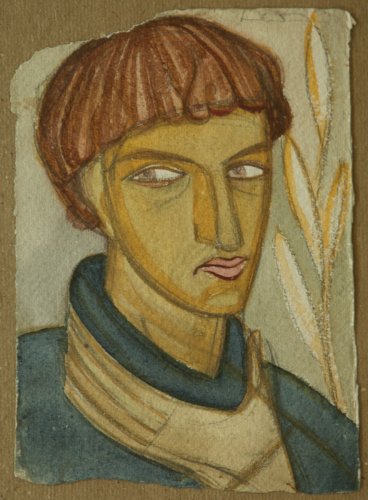Mykhailo Boychuk. Portrait of Vasyl Sedlyar (1927)
Mykhailo Boychuk is a Ukrainian monumental artist, a representative of the Ukrainian cultural renaissance of the beginning of the 20th century. An artistic phenomenon that combined the forms of folk art and the heritage of Byzantium and the Proto-Renaissance was named after him. The French called this trend Renovation Byzantine (neo-Byzantism), known today as Ukrainian monumentalism or boychukism.
Mykhailo Boychuk received an excellent art education with supporting of Metropolitan Andrei Sheptytskyi. At first he studied in Lviv, then in Vienna, Krakow, and later in Munich and Paris, he traveled to Italy twice to see the frescoes of Giotto and Cimabue.
After the success of 1910 at the Salon of Independents (Society of Independent Artists) in Paris, Boychuk returns to Lviv. Here he is engaged in the restoration of icons in the National Museum (now the Andrei Sheptytskyi National Museum). In 1917, he became one of the founding professors of the Ukrainian State Academy of Arts, where he headed the icon and fresco workshop. Boychuk taught students various artistic techniques in order to raise a universal artist. His students themselves produced materials for paintings according to the recipes found by the artist.

In the collection of the Mystetskyi Arsenal, there is a portrait of Vasyl Sedlyar (1927) created by Mykhailo Boychuk — one of Boychuk's brightest students, a teacher and director of the Mezhyhirya Art and Ceramic Technical School-Institute. It is made with watercolors on a small (smaller than A4 format) sheet of paper. Most of the composition is occupied by the head of a young man with short dark hair. The boy's elongated neck is emphasized by a blue sweater collar. Against its background, the illuminated brush of the hand, which rests this collar closer to the neck, stands out beautifully. The young man's gaze is directed to the left. In the background, on the right, the artist depicted a plant sprout. Boychuk often resorted to the interweaving of plant elements in his other works, appealing to ancient ornamentalism. All paints are very clean, in places almost transparent. The construction lines are clear, accurate, but at the same time they retain their smoothness, giving the whole figure roundness. In general, Boychuk paid great attention to the line, its capacity, because in each work he sought to achieve completeness of the content, using the most laconic means and forms. Two details should be highlighted in the portrait: emphasized large eyes and an elongated slender brush. They resemble those we are used to seeing on icons.
The picture Portrait of Vasyl Sedlyar by Mykhailo Boychuk was animated by Pause to Play animation studio.
Created as part of the Living Collection project
It is interesting that Oksana Pavlenko — another star of Boychukists and the wife of Vasyl Sedlyar — gave this portrait to Igor Dychenko’s collection. She is one of the few students of Mykhailo Boychuk who managed to survive the repressions and save some of the works of their associates.
Instead, both the author and the hero of the portrait met a tragic fate. Both were shot on the same day — July 13, 1937. All the monumental paintings of Boychuk and his students were destroyed. Those canvases and graphic sketches that survived were hidden for a long time in museum special funds or with the artist's friends. But even from a few fragments, one can get an impression of Boychukism as one of the bright and distinctive pages of the history of Ukrainian art. Exhibition Boychukism. The "Great Style" project of the Mystetskyi Arsenal (2017) was an attempt to explore and reconstruct this artistic direction.